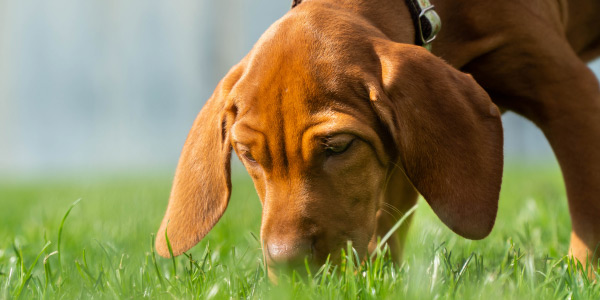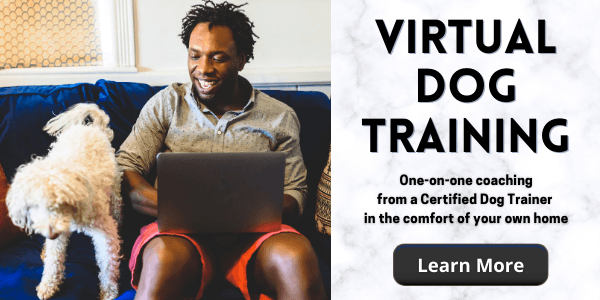 Leave It is one of the top 6 most important dog training commands that keep your dog safe, and it's easy to start training! Leave It training is a great impulse control exercise for your pup and teaches them that not everything in the world is theirs for the taking.
Leave It is one of the top 6 most important dog training commands that keep your dog safe, and it's easy to start training! Leave It training is a great impulse control exercise for your pup and teaches them that not everything in the world is theirs for the taking.
In the first few steps of training, your dog will learn that when you say "Leave It," they will be rewarded with something of equal or greater value. Then you'll work on practicing this cue in different environments and with different items that your dog is asked to leave alone. As you continue to practice, you'll be able to fade out treat rewards and use real-life rewards instead, such as praise, petting, an awesome dog toy, or — once you've made sure the thing they're interested in is safe to sniff — actually getting to check out the thing you just asked them to leave alone.
What Does Leave It Mean to Your Dog?
We use Leave It as a cue to tell a dog to turn away from something or ignore it. While in our human minds the action is not picking something up with their mouth, usually a dog associates this cue with the action of turning or pulling their head away, looking toward you, or continuing to follow you instead of stopping to check the item out.
Leave It is for BEFORE your dog actually has something in their mouth. If they've grabbed something already, that's the time to use the cue Drop It.
What You'll Need to Train Your Dog to Leave It
- Your clicker (or a marker word that tells your dog they got it right — like "Yes!")
- Two types of dog treats
- A lower-value food treat — this could be their regular dry kibble or tiny crunchy treats
- A higher-value food treat — such as freeze-dried treats or moist, fresh treats
How to Teach Your Dog to Leave It in 5 Easy Steps
Step One
- Place the lower value treat in a closed fist. Have the higher-value treat in your other hand out of the dog's view, or on a raised surface where it's easy to grab.
- Hold out your closed fist – your dog will most likely go to sniff your fist.
- Say “Leave it” just once and wait until they pull their head back or turn their head away. Patience is so important during this first step, so stick with it!
- Click (or say "yes!") for the action of pulling or turning away, then give a higher-value treat with your other hand.
- Repeat until your dog is consistently pulling their head away upon hearing the Leave It cue.
Step Two
- It's time to raise the stakes! Now hold the lower-value treat in an open palm but be ready to close your fist over it if your dog goes to eat it. You don't want your dog to be successful in grabbing the thing you just asked them to leave alone.
- Say “Leave It” just once and click for your dog pulling their head away.
- Reward with a higher value treat from the opposite hand.
- Repeat until your dog is consistent in pulling their head away from a treat sitting in your open palm.
- Randomly switch up which hand is holding the lower value treat and which is rewarding with the higher value treat.
Step Three
- Continue to increase your criteria by now placing the treat you’re asking them to leave alone on the floor but covered with your hand, so they cannot eat the treat you asked them to leave alone.
- Say “Leave It” just once, click and reward with a high-value treat when they pull their head away.
Step Four
- Now start to drop the treat from a small distance above the floor. You’re building your dog up to be able to leave rolling or moving pieces of food alone. Start just a few inches from the floor, then move higher and higher up.
- You can use your foot to cover the treat you asked them to leave alone if they move towards it as you work through this step.
- Click and treat when they pull their head away or don’t move towards the treat, and reward with a higher value treat.
Step Five
- Start to incorporate different kinds of items that you’re asking your dog to leave alone. These can include household items that your dog has shown interest in picking up before, such as socks, the remote control, a plate of food on the coffee table, or paper tissue.
- Begin to practice the cue in different rooms of your home, out in the yard, and out on your walks. Be prepared with a treat or favorite toy to reward them with.
- Remember, you don't want your dog to ever get the thing you asked them to leave unless you say the cue Take It to tell them it's okay.
- You can start fading out the use of your clicker and food treats as your dog shows fluency with their Leave It cue in different environments. However, if your dog has an amazing performance of Leave It, it's worthwhile to reward them with a yummy treat if you have one close by!
Watch me work with Fozzie Bear during his first introduction to Leave It as a puppy in the below video. The clips are from two separate training sessions on the same day. Each session only lasted about four minutes total. We worked through steps one through four from above, so you can see them in action.
Another great video tutorial is this one from Kikopup. She shows how leave it practice is wonderful for learning impulse control:
You can also take the opportunity to teach "Take It" at the same time as "Leave It" to your dog. These are paired cues. This video by Simpawtico shows how it's done:
Teaching Your Dog to Leave It Helps Keep Them Safe
It's extremely useful when food or medication falls on the floor, which can be toxic for dogs. Some dogs think of themselves as vacuum impersonators and will try to eat everything they encounter on the ground, whether at home or out on a walk. Being able to tell them to leave something alone prevents ingestion of harmful items or possible intestinal obstruction. This is an especially important cue if your dog likes to eat poop (whether their own or others').
Leave It is also an important skill to have in your training toolkit if you live in an area where your dog might come in contact with snakes. See this article about teaching your dog snake avoidance to learn how to apply Leave It in those potentially dangerous situations.
Take the time to practice this behavior consistently, as it is one of the most used day-to-day dog training cues and lends itself to a variety of situations. Regular positive reinforcement training builds better communication with your dog and a stronger relationship. Happy training!




